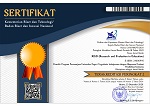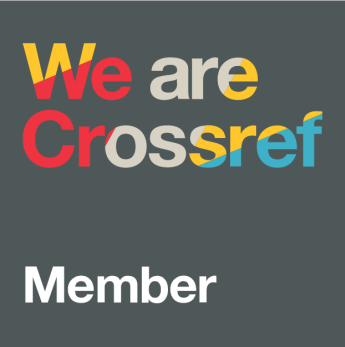Number sense profile of prospective elementary school teachers in blended Mathematics learning
DOI:
https://doi.org/10.21831/reid.v10i1.51394Keywords:
number sense, mathematics learning, blended learning, higher educationAbstract
References
AliustaoÄŸlu, F., Tuna, A., & Biber, A. í‡. (2018). Misconceptions of sixth grade secondary school students on fractions. International Electronic Journal of Elementary Education, 10(5), 591–599. https://doi.org/10.26822/iejee.2018541308
Almeida, R., Bruno, A., & Perdomo-Díaz, J. (2016). Strategies of number sense in pre-service secondary Mathematics teachers. International Journal of Science and Mathematics Education, 14(5), 959–978. https://doi.org/10.1007/s10763-014-9601-6
Ben-Yehuda, M., & Sharoni, V. (2021). Number sense makes all the difference: Calculation using number sense by pupils with and without learning difficulties in Math. Journal of Cognitive Education and Psychology, 20(1), 47–67. https://doi.org/10.1891/JCEP-D-20-00029
Can, D., & Yetkin í–zdemir, I. E. (2020). An examination of fourth-grade elementary school students' number sense in context-based and non-context-based problems. International Journal of Science and Mathematics Education, 18(7), 1333–1354. https://doi.org/10.1007/s10763-019-10022-3
Courtney-Clarke, M., & Wessels, H. (2014). Number sense of final year pre-service primary school teachers. Pythagoras, 35(1), 1–9. https://doi.org/10.4102/pythagoras.v35i1.244
Creswell, J. W. (2009). Research design: Qualitative, quantitative, and mixed methods approaches. Sage Publications. https://www.jstor.org/stable/1523157?origin=crossref
Dagdag, J. D., Palapuz, N. A., & Calimag, N. A. (2021). Predictive ability of problem -solving efficacy sources on Mathematics achievement. International Journal of Evaluation and Research in Education, 10(4), 1185–1191. https://doi.org/10.11591/IJERE.V10I4.21416
Dennis, M. S., Knight, J., & Jerman, O. (2016). Teaching high school students with learning disabilities to use model drawing strategy to solve fraction and percentage word problems. Preventing School Failure, 60(1), 10–21. https://doi.org/10.1080/1045988X.2014.954514
Er, Z., & Artut, P. D. (2018). Investigation of number sense strategies used by the 8th grade students in Turkey. Journal of Education and Training Studies, 6(7), 108-113. https://doi.org/10.11114/jets.v6i7.3170
Gerzel-Short, L., & Hedin, L. (2022). Purposeful use of high-leverage practices to teach number sense. Intervention in School and Clinic, 57(3), 19–24. https://doi.org/10.1177/10534512211014839
Ghazali, M., Mohamed, R., & Mustafa, Z. (2021). A systematic review on the definition of children's number sense in the primary school years. Eurasia Journal of Mathematics, Science and Technology Education, 17(6), 1–12. https://doi.org/10.29333/ejmste/10871
Gí¼ner, P., & Gí¶kí§e, S. (2021). Monitoring the nomological network of number sense studies. International Journal of Mathematical Education in Science and Technology, 52(4), 580–608. https://doi.org/10.1080/0020739X.2021.1895343
Gí¼ven, Y., & í‡olak, F. G. (2019). Difficulties of early childhood education teachers' in Mathematics activities. Acta Didactica Napocensia, 12(1), 89–106. https://doi.org/10.24193/adn.12.1.6.90
Hinton, V., Stroizer, S., & Flores, M. (2015). A case study in using explicit instruction to teach young children counting skills. Investigations in Mathematics Learning, 8(2), 37–54. https://doi.org/10.1080/24727466.2015.11790350
Khairani, A. Z., & Shamsuddin, H. (2021). Application of Rasch measurement model in developing calibrated item pool for the topic of Rational Numbers. Eurasia Journal of Mathematics, Science and Technology Education, 17(12), em2056. https://doi.org/10.29333/EJMSTE/11426
Lai, M. Y., & Wong, J. P. (2017). Revisiting decimal misconceptions from a new perspective: The significance of whole number bias in the Chinese culture. Journal of Mathematical Behavior, 47(May), 96–108. https://doi.org/10.1016/j.jmathb.2017.07.006
Lee, T., Newton, M., & Glass, B. (2021). Elementary Science teachers adapt their practice during a pandemic. Journal of Interdisciplinary Teacher Leadership, 5(1), 1–22. https://doi.org/10.46767/kfp.2016-0034
Mädamí¼rk, K., Kikas, E., & Palu, A. (2018). Calculation and word problem-solving skill profiles: Relationship to previous skills and interest. Educational Psychology, 38(10), 1239–1254. https://doi.org/10.1080/01443410.2018.1495830
Malone, A. S., & Fuchs, L. S. (2017). Error patterns in ordering fractions among at-risk fourthgrade students. Journal of Learning Disabilities, 50(3), 337–352. https://doi.org/10.1177/0022219416629647
Namkung, J. M., Fuchs, L. S., & Koziol, N. (2018). Does initial learning about the meaning of fractions present similar challenges for students with and without adequate whole -number skill? Learning and Individual Differences, 61(November 2017), 151–157. https://doi.org/10.1016/j.lindif.2017.11.018
Pentang, J. T., Ibañez, E. D., Subia, G. S., Domingo, J. G., Gamit, A. M., & Pascual, L. E. (2021). Problem-solving performance and skills of prospective elementary teachers in Northern Philippines methods. Journal of Hunan University Natural Sciences, 48(1), 122–132. http://jonuns.com/index.php/journal/article/view/500
Powell, S. R., & Nelson, G. (2021). University students' misconceptions about rational numbers: Implications for developmental mathematics and instruction of younger students. Psychology in the Schools, 58(2), 307–331. https://doi.org/10.1002/pits.22448
Purnomo, Y. W., Kowiyah, Alyani, F., & Assiti, S. S. (2014). Assessing number sense performance of Indonesian elementary school students. International Education Studies, 7(8), 74–84. https://doi.org/10.5539/ies.v7n8p74
Reys, R., Lindquist, M. M., Lambdin, D. V., & Smith, N. L. (2009). Helping children learn Mathematics (9 th ed.). John Wiley & Sons, Inc. https://doi.org/10.5951/AT.10.4.0179
Roell, M., Viarouge, A., Houdé, O., & Borst, G. (2017). Inhibitory control and decimal number comparison in school-aged children. PLoS ONE, 12(11), 1–17. https://doi.org/10.1371/journal.pone.0188276
Senol, A., Dundar, S., & Gunduz, N. (2015). Analysis of the relationship between estimation skills based on calculation and number sense of prospective classroom teachers. Procedia Social and Behavioral Sciences, 197(July), 1782–1788. https://doi.org/10.1016/j.sbspro.2015.07.236
Voronin, I. A., Ovcharova, O. N., Bezrukova, E. M., & Kovas, Y. (2018). Cognitive and non cognitive predictors of the unified state exam performance of students from schools with regular and advanced mathematical curricula. Psychology in Russia: State of the Art, 11(4), 177199. https://doi.org/10.11621/pir.2018.0412
Whitacre, I. (2018). Prospective elementary teachers learning to reason flexibly with sums and differences: Number sense development viewed through the lens of collective activity. Cognition and Instruction, 36(1), 56–82. https://doi.org/10.1080/07370008.2017.1394303
Yaman, H. (2015). The mathematics education I and II courses' effect on teacher candidates' development of number sense. Kuram ve Uygulamada Egitim Bilimleri, 15(4), 1119–1135. https://doi.org/10.12738/estp.2015.4.2322
Yang, D. C., & Sianturi, I. A. J. (2019). Assessing students' conceptual understanding using an online three-tier diagnostic test. Journal of Computer Assisted Learning, 35(5), 678–689. https://doi.org/10.1111/jcal.12368
Yang, D. C., & Sianturi, I. A. J. (2021). Sixth grade students' performance, misconception, and confidence on a three-tier number sense test. International Journal of Science and Mathematics Education, 19(2), 355–375. https://doi.org/10.1007/s10763-020-10051-3
Yang, D. C., & Wu, W. R. (2010). The study of number sense: Realistic activities integrated into third-grade math classes in Taiwan. Journal of Educational Research, 103(6), 379–392. https://doi.org/10.1080/00220670903383010
Zhou, M., & Chua, B. L. (2016). Using blended learning design to enhance learning experience in teacher education. International Journal on E-Learning, 15(1), 121–140. https://www.learntechlib.org/primary/p/41984/
Downloads
Published
How to Cite
Issue
Section
Citation Check
License
The authors submitting a manuscript to this journal agree that, if accepted for publication, copyright publishing of the submission shall be assigned to REID (Research and Evaluation in Education). However, even though the journal asks for a copyright transfer, the authors retain (or are granted back) significant scholarly rights.
The copyright transfer agreement form can be downloaded here: [REID Copyright Transfer Agreement Form]
The copyright form should be signed originally and sent to the Editorial Office through email to reid.ppsuny@uny.ac.id

REID (Research and Evaluation in Education) by http://journal.uny.ac.id/index.php/reid is licensed under a Creative Commons Attribution-ShareAlike 4.0 International License.







.png)





